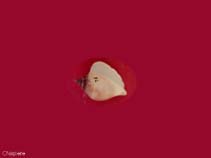Laevistrombus canarium (Linnaeus, 1758)
Dog conch
Classification / Names Common names | Synonyms | CoL | ITIS | WoRMS
Gastropoda | Littorinimorpha | Strombidae
Environment: milieu / climate zone / depth range / distribution range Ecology
Benthic; depth range 0 - 55 m (Ref. 349). Tropical
Distribution Countries | FAO areas | Ecosystems | Occurrences | Introductions
Indo-West Pacific: from southern India and Sri Lanka to Melanesia; north to Japan and south to Queensland and New Caledonia.
Length at first maturity / Size / Weight / Age
Maturity: Lm ? range ? - ? cm Max length : 10.0 cm ShH male/unsexed; (Ref. 349); common length : 6.5 cm SHL male/unsexed; (Ref. 349)
Short description Morphology
Upper body whorl globose. Spire moderately low but wide as compared to other Laevistrombus species. Upper lip toward the posterior end straight. Colouration: Base dorsal color white with brown or brown tan wavy line (Ref. 128177).
Commercially fished for food in many parts of South East Asia (Ref. 349). Abundant in larger islands and continental shores. Occurs at the low tide mark (Ref. 349).
Life cycle and mating behavior Maturity | Reproduction | Spawning | Eggs | Fecundity | Larvae
Members of the order Neotaenioglossa are mostly gonochoric and broadcast spawners. Life cycle: Embryos develop into planktonic trocophore larvae and later into juvenile veligers before becoming fully grown adults.
Main reference
References | Coordinator | Collaborators
Poutiers, J.M. 1998. (Ref. 349)
IUCN Red List Status (Ref. 130435)
CITES status (Ref. 108899)
Not Evaluated
CMS (Ref. 116361)
Not Evaluated
Threat to humans
Harmless
Human uses
Fisheries: commercial
| FishSource |
Tools
More information
Internet sources
BHL | BOLD Systems | CISTI | DiscoverLife | FAO(Publication : search) | Fishipedia | GenBank (genome, nucleotide) | GloBI | Gomexsi | Google Books | Google Scholar | Google | PubMed | Tree of Life | Wikipedia (Go, Search) | Zoological Record
Estimates based on models
Preferred temperature
(Ref. 115969): 24.7 - 29.1, mean 28.1 (based on 1402 cells).
Resilience
(Ref. 69278):
High, minimum population doubling time less than 15 months (K=0.79-1.5).



